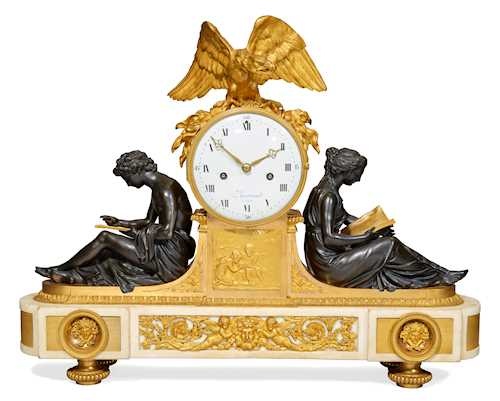MANTEL CLOCK "L'ÉTUDE ET LA PHILOSOPHIE" Louis XVI, Paris. The case after a drawing by François Rémond, the figures after a model by Simon-Louis Boizot, ca. 1785. The dial signed "Bertrand à Paris".
White marble and gilt and dark-patinated bronze. Cylindrical clock case, the top featuring an eagle, and the sides featuring allegorical figures of Philosophy and Study in dark-patinated bronze. The pedestal front with a gilt bronze plaque depicting two Cupids with a bird. On a marble plinth on spherical feet. White enamel dial. Parisian movement, striking the 1/2-hour on bell.
69 × 16 × 55 cm.
Chips to the edge of the marble, dial with hairline cracks and restorations. Hands probably replaced.
Provenance: Belgian private collection.
The figural depiction of the Allegory of Study, which shows a writing youth and a reading female counterpart, probably goes back to a drawing by Simon-Louis Boizot from 1780 for the Porcelain Manufactory Sèvres. The marchand-mercier Dominique Daguerre came up with the idea of using the drawing for bronze figures, which he commissioned François Rémond to make into a mantel clock. Ottomeyer/Pröschel note the unusual iconography of the two Cupids on the dial base (Cf. Ottomeyer/Pröschel, Vergoldete Bronzen, Munich, 1986, Vol. I, p. 295, with illustrations). The model enjoyed great popularity, so that the clocks found their way into renowned collections, including those of the Queen of England, the Palace of Versailles or the Musée des Arts Décoratifs in Paris (Inv. No. 2014.112.26).
The clock model is also depicted in: Elke Niehüser, Die Französische Bronzeuhr - Eine Typologie der figürlichen Darstellungen, Munich, 1997, pp. 86 & 219, Ills. 134 and 450.
Literature:
- Gerald van der Kemp, Le conservateur en chef de Musée de Versailles et des Trianons, Versailles, published by Parklane, New York, full-page illustration, p. 124.
- Jean Dominique Augarde, Les Ouvriers du temps: la pendule à Paris de Louis XIV Napoleon I/ Ornamental clocks and clockmakers in 18th century Paris, Edition Antiquorum, Ill. on p. 206 (here, also with slightly different relief decoration in the base).
- Ottomeyer/ P. Pröschel, Vergoldete Bronzen - Die Bronzearbeiten des Spätbarock und Klassizismus, Munich 1986, Vol. I, p. 195, Ill. 4.17.5.
- P. Verlet, Les Bronzes dorés français du XVIIIe siècle, Paris 1987, p. 322, Ill. 357, a clock from the Ministère des Affaires Etrangères (Inv. No. 842014).
View it on
Sale price
Estimate
Time, Location
Auction House
White marble and gilt and dark-patinated bronze. Cylindrical clock case, the top featuring an eagle, and the sides featuring allegorical figures of Philosophy and Study in dark-patinated bronze. The pedestal front with a gilt bronze plaque depicting two Cupids with a bird. On a marble plinth on spherical feet. White enamel dial. Parisian movement, striking the 1/2-hour on bell.
69 × 16 × 55 cm.
Chips to the edge of the marble, dial with hairline cracks and restorations. Hands probably replaced.
Provenance: Belgian private collection.
The figural depiction of the Allegory of Study, which shows a writing youth and a reading female counterpart, probably goes back to a drawing by Simon-Louis Boizot from 1780 for the Porcelain Manufactory Sèvres. The marchand-mercier Dominique Daguerre came up with the idea of using the drawing for bronze figures, which he commissioned François Rémond to make into a mantel clock. Ottomeyer/Pröschel note the unusual iconography of the two Cupids on the dial base (Cf. Ottomeyer/Pröschel, Vergoldete Bronzen, Munich, 1986, Vol. I, p. 295, with illustrations). The model enjoyed great popularity, so that the clocks found their way into renowned collections, including those of the Queen of England, the Palace of Versailles or the Musée des Arts Décoratifs in Paris (Inv. No. 2014.112.26).
The clock model is also depicted in: Elke Niehüser, Die Französische Bronzeuhr - Eine Typologie der figürlichen Darstellungen, Munich, 1997, pp. 86 & 219, Ills. 134 and 450.
Literature:
- Gerald van der Kemp, Le conservateur en chef de Musée de Versailles et des Trianons, Versailles, published by Parklane, New York, full-page illustration, p. 124.
- Jean Dominique Augarde, Les Ouvriers du temps: la pendule à Paris de Louis XIV Napoleon I/ Ornamental clocks and clockmakers in 18th century Paris, Edition Antiquorum, Ill. on p. 206 (here, also with slightly different relief decoration in the base).
- Ottomeyer/ P. Pröschel, Vergoldete Bronzen - Die Bronzearbeiten des Spätbarock und Klassizismus, Munich 1986, Vol. I, p. 195, Ill. 4.17.5.
- P. Verlet, Les Bronzes dorés français du XVIIIe siècle, Paris 1987, p. 322, Ill. 357, a clock from the Ministère des Affaires Etrangères (Inv. No. 842014).



